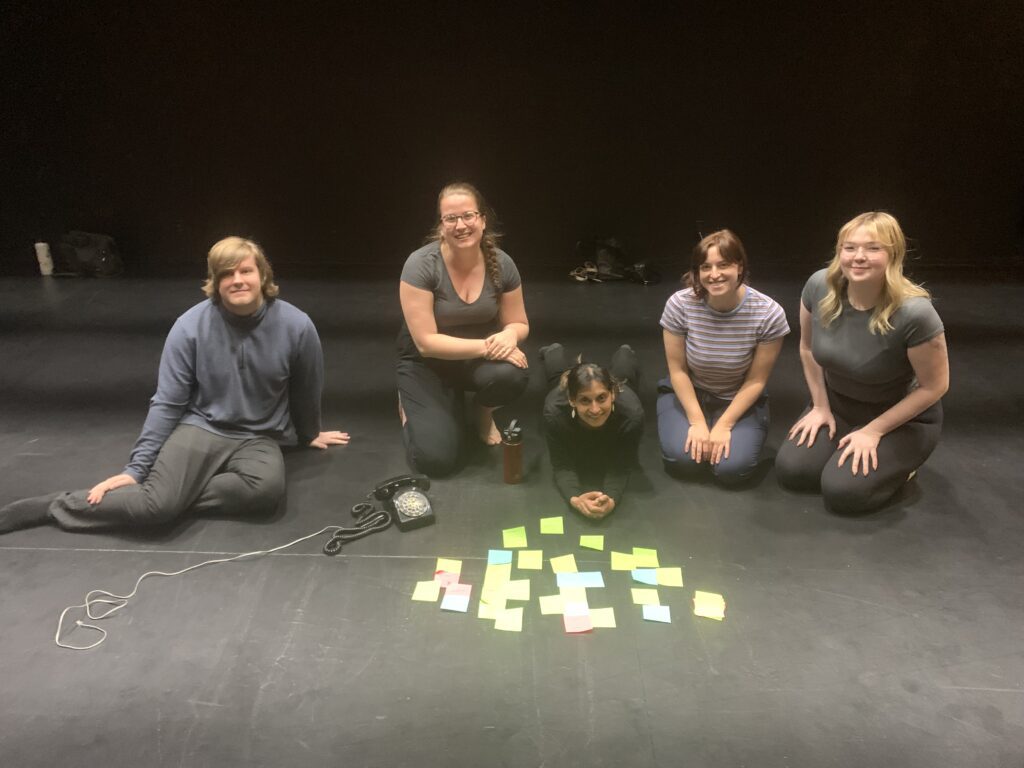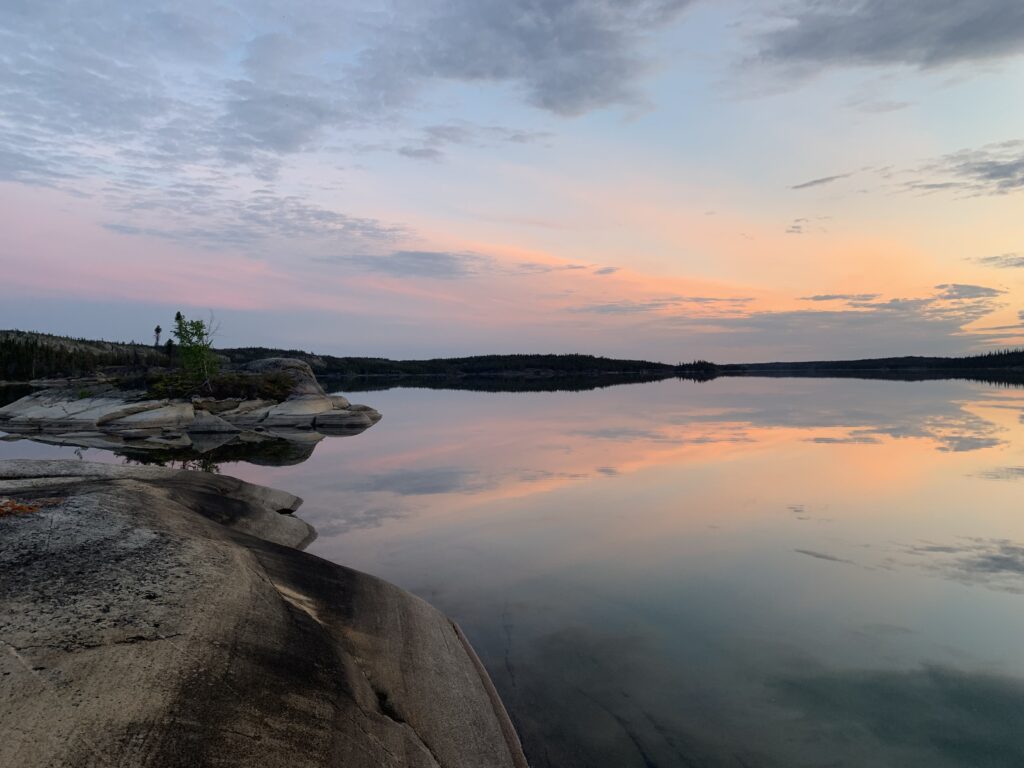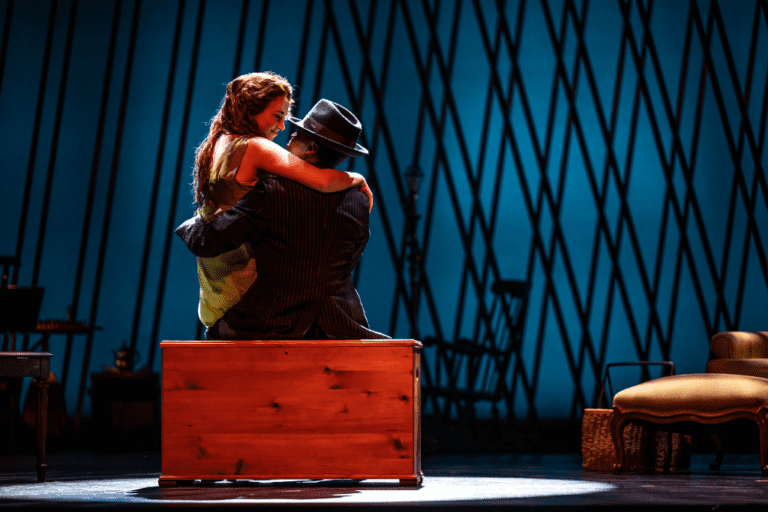What can Toronto theatre learn from Yellowknife?
I watch the midnight sun dance across Great Slave Lake.
The sky is always dramatic here in Yellowknife. Sunsets are longer and bolder. So much of the art in the north is inspired by the land. I’ll find this to be true for my art, too, as I enter the small Northwest Territories arts scene.
Growing up in Toronto, the Northwest Territories were always a distant idea, a place I knew only from colouring in elementary school maps.
But over the summer, I came to see Yellowknife in a different light, both through the eyes of my PhD-enthralled partner and as an artist myself, in an experience that completely shifted the naive perspective taught to me by grade five geography and incomplete Canadian history lessons. Instead of a rural, snow-covered land, I found a passionate, creative community that tends to appreciate a slower pace of life.
This June, I headed north to spend time as an artist educator, facilitating movement and writing-based drama workshops at Bella Dance Academy. These were the first workshops I’d ever designed and taught entirely myself, and I didn’t know what to expect. Not just of myself and the work, but of the participants and community, so far removed from the bigger industries I’ve known in Toronto and London, U.K.
But once I settled in, any anxiety I’d felt melted away like ice.
Finding community in the Northwest Territories
So who lives in Yellowknife — and why would an Ontario-based artist want to go so far away to make things, when Toronto is seemingly full of creative opportunities?
After being in the north for six weeks this summer, I believe us big-city creatives have a lot to learn from the carefree artists in the subarctic.
“Often, people’s love of the North comes from the community, and the artistic community is no exception… people who really value the development of arts and culture,” said Kacie Hall, operations and communications manager at the Northern Arts and Cultural Centre (NACC). I connected with Kacie through Marie Coderre, artistic director of the NACC. Kacie was born and raised in Yellowknife, and we instantly hit it off. We connected over our mutual love for devised theatre, and I could tell early on in our friendship she was itching for new theatre endeavours. Within the local community in Yellowknife, there’s a distinct willingness to explore and be curious, and if you want to make something happen, you can.
So we did.
Separately from my other workshops, Kacie and I ran an “intro to devising” workshop over several days. We had lovely participants who jumped into the work with keen minds and bodies. The participants were so enthusiastic, which refreshed my own passion for new work creation.

Because I’ve been feeling quite jaded, or, dare I say, defeated, in Toronto. Sometimes the thing you love most can give you a lot of grief. The career of an artist is not a safe 9-5, with a new promotion every other year. You get rejected or ignored constantly, and the direct, unpaid work you put in often bears no fruit.
The workshops in Yellowknife were a welcome interruption to my city-imposed impostor syndrome. By the end of our time together, our devising workshop produced a 12-minute work-in-progress, which we shared with a small audience and followed with a talkback that allowed the creators to engage with feedback.
One participant, drama teacher and creative Gwenan Guillas-Letain, said that Yellowknife’s community of artists constantly gives her inspiration. She missed the small-town creative energy of her hometown, Dauphin, Manitoba, while living in Winnipeg. When she then moved to Yellowknife to start an artist-teacher career, it rekindled her drive to create and perform. “It is an exciting place to live a creative life,” she told me.
Since Yellowknife has a population of 20,000 people, there are of course fewer creative opportunities to jump into than in Toronto. Its theatre industry isn’t comparable to other capital cities across the country. The NACC doesn’t really produce in-house productions. Akpik Theatre is the only other professional (and Indigenous) theatre company with operations in Yellowknife.
However, because of this relative lack of opportunity, there’s an eagerness among creatives to keep feeding that artistic community. Although small, Yellowknife is still a capital and hub of the North, and has a young, interesting crowd who want to participate in a creative arts scene and do things. I found that the work I did encounter and learned about was heavily focused on local stories. Many young people move to Yellowknife in order to find community and connection.
Of course, this comes with a flip side.
When Kacie moved back to Yellowknife from drama school in Alberta, it wasn’t without anxieties. She told me that as an artist in N.W.T., it’s vital to initiate creativity yourself. That’s true anywhere, I think, but it requires a different kind of effort in a place the national industry isn’t looking (yet), and where people aren’t regularly exposed to different types of theatre.
Toronto can feel like a bubble. I’m not implying that all artists should have a stint in the Far North to remove their Toronto-tinted glasses, nor do I wish to hate on the city that raised me and nurtured my creative drive — a city that has murals on every building, tons of new work, and a corner of creatives I’ve been lucky to meet.

The only problem? Those friends and I all feel a bit lost in the sauce — and I’ve constantly heard similar sentiments from other Toronto artists. Toronto, although full of life and opportunity, suffers from the oxymoron of stagnant possibilities. An oversaturated market that causes the dreamer in an artist to feel stuck.
In the North, I knew who the muralist was (Derek Simmers — check him out). During my stint in Yellowknife, I found that everyone I met, either through my own workshops or at Makerspace YK, was willing to build lasting connections. The life of an artist can feel a little DIY wherever you are, and connection is the most valuable material. I’m even a professional visual artist now, thanks to The Gallery on 47th Street. They agreed to show my paintings — no hesitation, just spontaneity. Yellowknife is a “yes girl.”
The moments I love in Toronto are those I spend with my creative network. When we see each other at a show and then debrief together after over fries, or when we get together and have a reading of a friend’s new play, it lights up our souls, and we get a little fuel back. We need more of that, and we need to be able to find it easier. There does exist community programming and outreach in Toronto, but it doesn’t feel mainstream. Shoutout to the institutions who do prioritize community-building events; The Theatre Centre’s community meals, and really everything at Jumblies Theatre and Shadowland Theatre, come to mind.
What can Toronto learn from Yellowknife?
First and foremost, community building has to be seen as a priority on a large scale.
Community-oriented programming that aims to connect and nurture artists doesn’t seem to be a priority for funding bodies, but it should be. Artists need room to grow and actually make and share things together, without vying for only five spots in a curated festival for emerging artists. For example, last year the Paprika Festival had 190 applicants for around 15 spots in various programs. This year, they are restructuring to have three programs run biannually — so even fewer opportunities per year. Will artists still apply and hope for the best? Yes, of course, but 90 per cent will face disappointment.
Listen, I’m just a forever emerging artist from North York, up against the big decision makers. What do I know?
I’m not sure I have a definitive answer. All I know to be true is that artists want connection — humans want connection — and, easy or challenging, they search for it wherever they go. In Yellowknife, finding that community was easy. It filled my artist’s soul.

And look: I know from experience that most of us in Toronto just accept that things are the way they are, and that’s what we have to deal with. At this point in my career, six years out of theatre school, I’m rethinking what really matters to me on this path.
Why does what we’re doing as artists matter? For me, the answer always comes back to the people. The way art changes us and lets us learn more about ourselves and each other. Let’s talk about that more. Yellowknife remembers that, intrinsically, the arts are the only authentic connective tissue of humanity.
At the end of the day, Toronto is not going to stop being a huge city, and the country’s biggest industry hub. I still love it and hate it at the same time — it’s a complex relationship with attachment issues. There’s so much excitement, creative energy, and power in this city. So many possibilities, and so many barriers. So many people, and so much diversity.
But branching out from this turbulent river of emotional whiplash, Toronto could use some calm, steady, and accessible streams.
My big takeaway from my time in Yellowknife is that if we keep the perspective of community in the front of our minds, our minds will thank us in the long run. I’m going to keep choosing my own adventure with this perspective guiding my practice, no matter where I might venture next. And it’s really good to venture out once in a while — even if it means needing a parka in May.









Shelly and Cynthia both expressed beautifully some of my own thoughts! I enjoyed reading and learning from your article and how your experiences are guiding you in your growth as an artist and an exceptional human.
Your paintings inspire emotional responses in me, each one seems to reflect a different aspect of your own inner journey. May you continue to go from strength to strength.
Sophie
Your work has deeply moved me, and I wanted to take a moment to express my admiration. The way you channel creativity into your art while simultaneously sharing your journey with others is truly inspiring. Your dedication to continuous growth and willingness to educate others along your path shows not only generosity of spirit but also a genuine passion for your craft.
What particularly resonates with me is how authentically you express yourself through your work. Each piece seems to carry a story, and your commitment to developing your artistic voice while helping others find theirs is remarkable.
Thank you for sharing your talents and insights for an artistic world of differences and similarities between TO and NWT. Your journey toward artistic excellence, combined with your educational spirit, creates a rippling effect that inspires others to pursue their own creative paths.
This is a wonderful piece of writing Soph. I have more insight into your creative life and only wish you continue on this path. As an artist, I don’t imagine you have a choice.
Lots of love always.